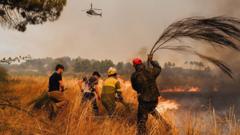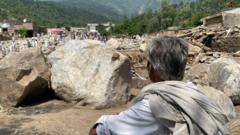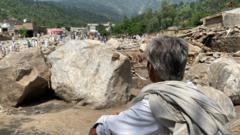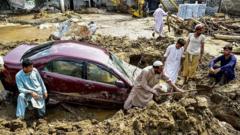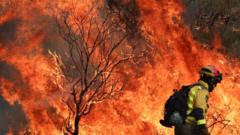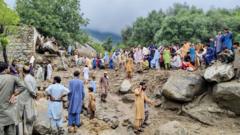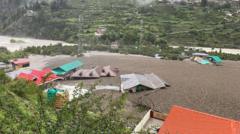Flash floods in Pakistan and Pakistan-administered Kashmir have resulted in over 300 confirmed fatalities, primarily in Khyber Pakhtunkhwa. The region is grappling with the devastating effects of heavy rainfall, prompting disaster zones to be declared as authorities warn of ongoing weather threats.
Devastating Flash Floods Claim Over 300 Lives in Pakistan and Kashmir
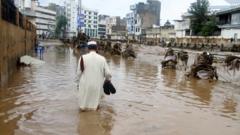
Devastating Flash Floods Claim Over 300 Lives in Pakistan and Kashmir
Heavy monsoon rains lead to catastrophic flooding and landslides, highlighting the urgent impacts of climate change.
The death toll from catastrophic flash floods and landslides in Pakistan and Pakistan-administered Kashmir has escalated, confirming at least 307 fatalities as rescue efforts continue. Most casualties have been reported in Khyber Pakhtunkhwa province, where disaster authorities have also noted that more than 74 homes have been destroyed. A tragic incident involved a rescue helicopter crashing during operations due to adverse weather conditions, resulting in the loss of five crew members.
In the neighboring Pakistan-administered Kashmir, the death toll has risen to nine, while additional fatalities have occurred in the northern Gilgit-Baltistan region. Government forecasts predict relentless heavy rains until August 21, prompting authorities to declare several areas as disaster zones as communities brace for further devastation.
Survivors recount harrowing experiences, with one individual describing the floods as resembling "doomsday," expressing how the earth shook violently with the torrential waters. The chief minister of Khyber Pakhtunkhwa announced a day of mourning as the region grappled with overwhelming grief.
In Indian-administered Kashmir, rescues are ongoing as teams recover bodies from mud and debris following severe flooding that has claimed at least 60 lives, with many more unaccounted for.
Seasonal monsoon rains, typically from June to September, contribute to the majority of South Asia's annual precipitation, yet this year there have been unprecedented figures - with Punjab, accommodating nearly half of Pakistan's population, documenting a staggering 73% increase in rainfall compared to the previous year, resulting in more deaths than the entire preceding monsoon season.
Climate change is exacerbating the intensity and frequency of such extreme weather events in the region, according to scientists, with glaciologists warning that the rapid melting of glaciers creates even more instability. The combination of intensified rainfall and vulnerable geological conditions is rendering these mountainous regions highly susceptible to devastating floods and landslides.


